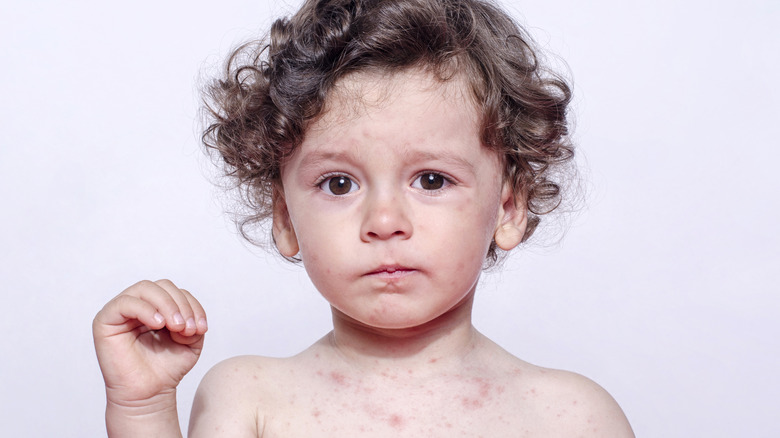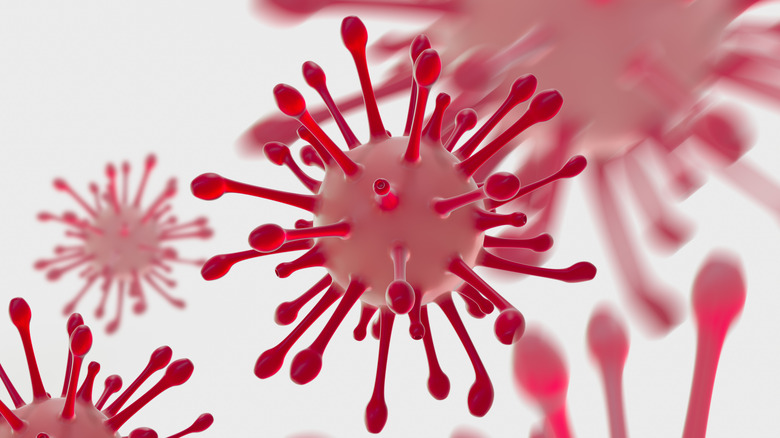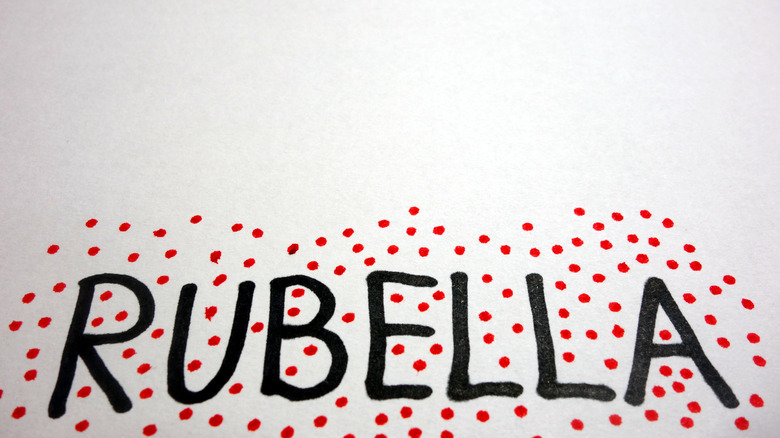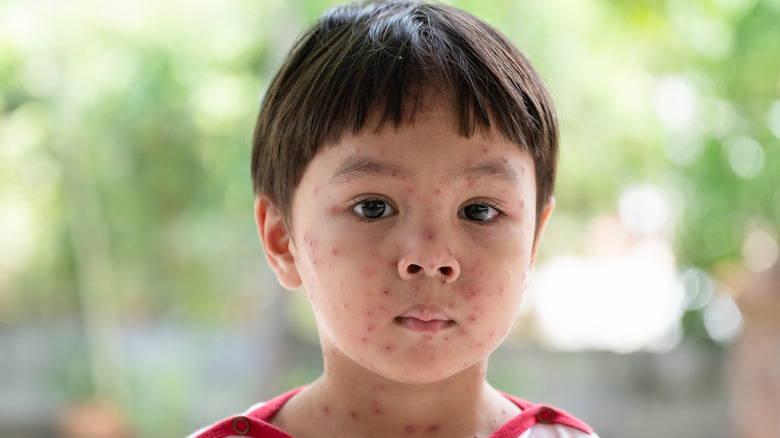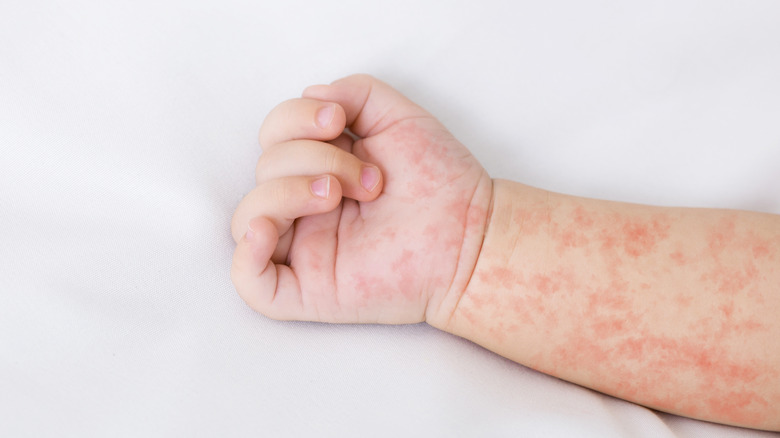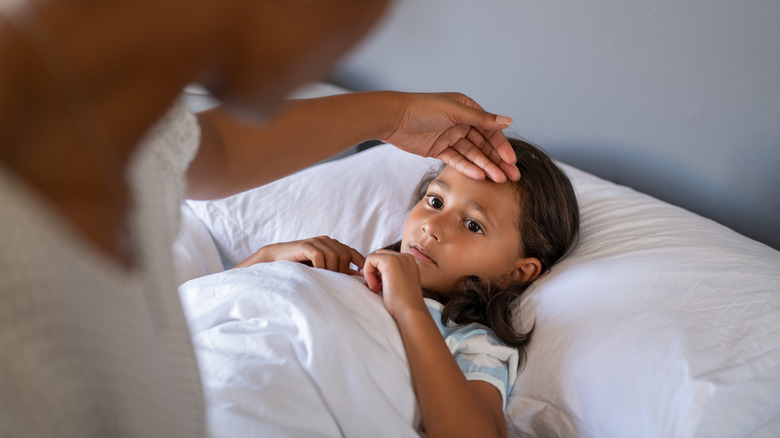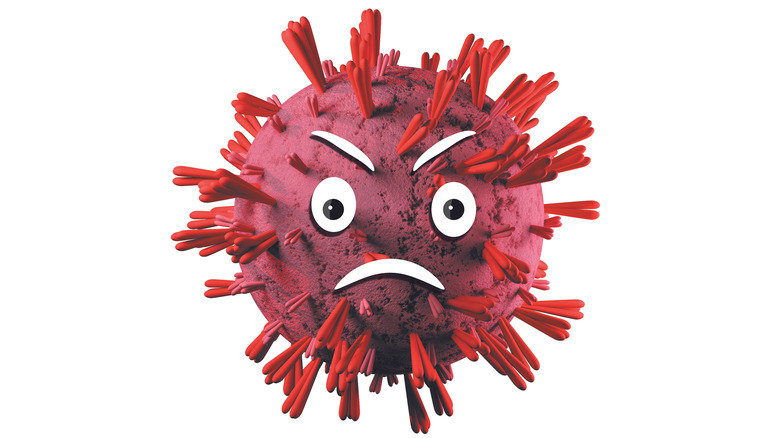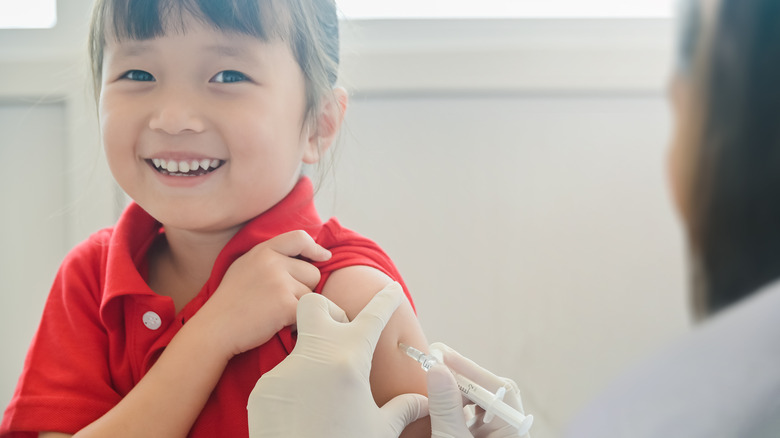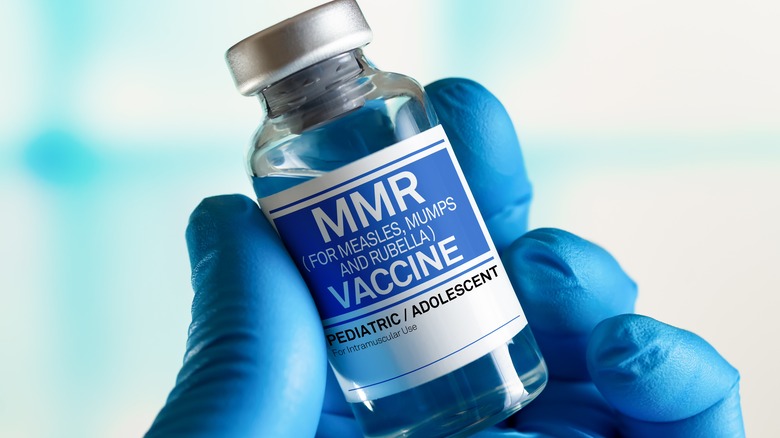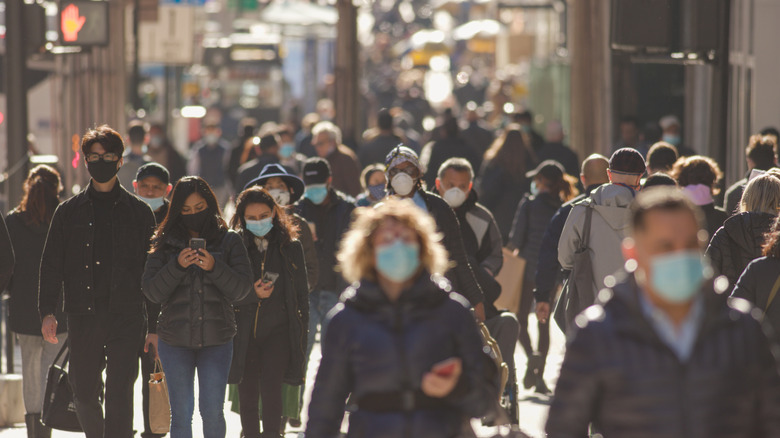Everything You Need To Know About Rubella
Isn't it just awful when one day you feel like your best self, then the next you're hit with this feeling of fatigue, an annoying cough, and an overall uncomfortable feeling that seems to have come out of nowhere? If this sounds familiar to you, chances are you've already experienced what it's like to have a viral infection.
According to National Geographic, viruses are very small microorganisms that must use cells from another living organism (i.e., a host) — be it human, animal, plant, or even bacteria — to multiply and proliferate. Although they are small, viruses can cause serious damage to the host they infect by multiplying really fast to create large numbers. Most of the time, a healthy body can kill the invading virus on its own. But sometimes, it needs a little help. That's where medicines and, most importantly, vaccines come in.
Think of vaccines as a safer way to get an infection. They train your body to fight, so that if you get infected by the real thing, your body knows exactly what to do to stop it from causing more damage (per the World Health Organization). One such infection that can be — and is already being — prevented by vaccines is rubella.
The rubella virus
Historical documents tell us that the rubella virus has been around for at least 250 years. The earliest account of the disease was made in the 1700s by a German doctor named Friedrich Hoffmann (per Britannica), but it's possible that the virus has been around for much longer than that.
To this day, virologists are still unsure where viruses came from. Some believe that they originated from genetic material that suddenly became motile; some say they were once part of other microorganisms; while others think that they existed even before any other living thing, and that they evolved together with the organisms they inhabited (via Scitable). But if history has taught us anything about viruses, it's that they are persistent little beings, and they are here to stay.
For the longest time, the rubella virus has been the sole member of the genus Rubivirus. But according to a 2020 study published in Nature, a team of researchers discovered two new viruses — the ruhugu virus and the rustrela virus — which are the first documented relatives of the rubella virus. The ruhugu virus was isolated from bats in Uganda, while the rustrela virus was isolated from a donkey, a kangaroo, and mice in a German zoo. While this discovery is concerning for the possibility of rubella-like infections to arise in the future, the authors believe that these viruses can broaden our understanding of rubella and open doors to comparative research that wasn't possible before.
Who's at risk for contracting rubella?
According to the National Organization for Rare Disorders (NORD), rubella is a highly contagious infection caused by the rubella virus. It's often referred to as three-day measles or German measles, but shouldn't be confused with measles, which is a completely different viral infection caused by the measles virus. Setting aside the confusing terminology, it's important that we talk more about how rubella impacted the lives of our ancestors, and what has changed since then.
Unlike its recently discovered relatives, the rubella virus is known to infect only humans. Before rubella vaccination in the United States was initiated in 1969, outbreaks of rubella occurred frequently, according to the Centers for Disease Control and Prevention (CDC). The last outbreak happened between 1964 to 1965 and affected nearly 12.5 million Americans. Once widespread vaccination began however, the number of rubella cases started declining quickly. As of 2004, the disease is considered to be eliminated in the U.S.
However, the disease is still present in other countries. Per the CDC, cases that get reported in the U.S. are from people who got infected while traveling or living overseas. Fortunately in 2012, the Measles & Rubella Initiative was created through the collaborative efforts of the American Red Cross, CDC, World Health Organization (WHO), United Nations Foundation, and UNICEF. To date, they continue to work with countries around the world to help them eradicate measles and rubella permanently.
Signs and symptoms of rubella
Most people who have rubella may not be aware that they have it because the symptoms are usually mild, or sometimes there aren't any symptoms at all. According to Healthline, for those who do have symptoms, chances are they were exposed to the virus two to three weeks prior, and they can expect their symptoms to last up to a week.
Signs and symptoms of rubella may differ depending on your age and sex. Common symptoms include low-grade fever of under 102 degrees Fahrenheit, headache, red and itchy eyes, runny or congested nose, swollen and painful lymph nodes around the head and neck area, muscle and joint aches (more common in young women), and a characteristic widespread rash (via Mayo Clinic). The Cleveland Clinic adds that a person with symptoms of rubella can also experience a general discomfort, sore throat, cough, loss of appetite, nausea, and temporary testicular pain in men. Diarrhea is also a common finding in children (per Children's National).
Rubella rash
As Children's National describes, one to five days following the nonspecific symptoms of rubella, a widespread rash with a distinct pattern may appear. The spots are small, red or pink, with a mixture of flat and raised surfaces. The rash begins on the face, then continues down the body, arms, and legs, until it disappears after three to five days in the same order it appeared. The duration of the rash is what inspired one of rubella's alternate names, "three-day measles," according to WebMD.
But according to Medical News Today, in babies who are born from mothers who contracted rubella while they were pregnant, a different and unique type of rash appears called "blueberry muffin rash." The lesions are dark, blue, or purple, and they form on the face and body.
These two types of rubella rashes can be distinguished from other infections like rubeola, roseola, and fifth disease (via Children's National). The rash of rubeola looks and spreads the same way as the rash of rubella. However, the small, pin-point rubeola spots eventually combine to form one giant rash, which doesn't happen in rubella. In roseola, the rash appears as the fever goes away and begins on the torso before it spreads outward to the face, arms, and legs. And the rash of fifth disease begins on the cheeks, making a person look as if their cheek was slapped, then spreads to the rest of the body. The rash may reappear on exposure to sunlight, extreme temperature, and skin trauma.
How is rubella diagnosed?
A diagnosis of rubella is made by a doctor using a combination of a person's medical history, physical examination, and certain laboratory tests. Important parts of the medical history include vaccination status and travel history. Since rubella has been eradicated in the United States, you may contract rubella if you had any recent travel to, or exposure to someone who traveled to, a country known to have cases of rubella (per the CDC). Your risk also greatly increases if you're not vaccinated.
Because rubella symptoms are hard to distinguish from other viral infections, a diagnosis based on history and physical examination alone isn't usually enough. A doctor may order specific laboratory tests to confirm the diagnosis. These tests are usually only done in high-risk populations, such as pregnant women, patients with encephalitis, and newborns (from Merck Manuals).
According to WebMD, a rubella test is done by checking your blood for the presence of antibodies specific to the rubella virus. Antibodies, such as immunoglobulin M (IgM) and immunoglobulin G (IgG), are cells that the body makes to help fight an infection. The CDC says that more than 90% of rubella cases will be positive for IgM five days after symptoms begin. However, false-positive results can occur. Another test, rubella IgG antibody avidity, can be used to differentiate between a recent or remote infection of rubella. This is particularly useful in pregnant women, who if they become infected are at great risk of transmitting the rubella virus to their baby during the first trimester.
What is the treatment for rubella?
No medicine exists to treat rubella. That's because most of the time, the infection just goes away on its own. Per Rubella, treatment for rubella is mostly supportive, which means treating the symptoms and not the disease itself. This includes plenty of bed rest, fever reducers, and non-steroidal inflammatory drugs (NSAIDs).
The Mayo Clinic warns that aspirin should never be given to children and teenagers for fever or muscle aches because of its link to a rare but dangerous condition called Reye's syndrome. Acetaminophen and ibuprofen are better options.
If you're looking for a more natural remedy, try honey. A 2015 review published in The Malaysian Journal of Medical Sciences suggests that natural honey may help in fighting many microbes and parasites, including the rubella virus. According to the authors, honey's ability to draw water out of its surroundings, and its high sugar content, acidity, and ability to produce hydrogen peroxide, are responsible for its antimicrobial properties. According to Healthline, taking ½ to 1 tablespoon of a specific type of honey called Manuka honey can help relieve a sore throat and make your immune system stronger, among many other things. Although honey is generally safe to eat or drink for most people, it should still be taken in moderation — too much can cause your blood sugar level to go up, which is something you want to avoid if you have diabetes. And always remember that infants under one year old should never be given honey due to the risk of botulism (via Nemours KidsHealth).
Is rubella dangerous?
Most people who get infected with rubella recover within a few weeks — with a few exceptions. According to the CDC, rare but serious complications from a rubella infection include brain infections and bleeding problems. A more common sequelae is arthritis, which can occur in up to 70% of adolescents and women who contract the virus.
Most vulnerable to rubella are babies whose mothers got infected during the first trimester. Although the disease will be mild in the mother, many things can happen to the unborn child. He or she can die early or late in the pregnancy, or be born with birth defects that can cause problems in the heart, eyes, ears, brain, liver, or spleen (per the U.S. Department of Health & Human Services). This is called congenital rubella syndrome.
Interestingly, the Children's Hospital of Philadelphia recounts that before the rubella vaccine was rolled out in the United States, pediatricians used to recommend "rubella parties," which exposed young girls to the virus. The exposure helped their bodies make antibodies specific to rubella, which in turn protected them in case they encountered the virus again when they were old enough to get pregnant.
How do I protect myself from rubella?
Rubella is a highly contagious viral infection, and it spreads through contact with an infected person (via Rubella). When someone sneezes, coughs, or talks, small particles from their respiratory tract mix with the air. In a person who has rubella, these particles contain the virus, and transmission happens when an uninfected person inhales or comes into contact with them. From there, the virus multiplies, spreads to other parts of the body, and causes symptoms. A person with rubella can spread the infection to other people between eight days before and eight days after the rash develops. The CDC adds that even if a person doesn't have symptoms (which happens in 25-50% of people with rubella), they can still transmit it to other people.
Because rubella is airborne, it can be almost impossible to know if the air that you breathe in has the virus or not. The good news is, if you're in the United States, the chance of that happening has been extremely small ever since the eradication of rubella in 2004. But if you're traveling to places that still have rubella, like Africa, the Middle East, and some parts of Asia, or if you come into contact with someone who was recently in any of those areas, your risk of contracting rubella greatly increases (per Medical News Today). Because of this possibility, it's important that you take measures to protect yourself. The best way to do this is through vaccination.
What is the measles, mumps, rubella (MMR) vaccine?
The National Museum of American History recalls that in 1969, following the last rubella outbreak in the United States, three rubella vaccines were successfully made — Meruvax, Rubelogen, and Cendevax. Nationwide vaccination was initiated, and in 1971 the rubella vaccine was combined with the measles and mumps vaccines to create the MMR vaccine. In 1979, an even better rubella vaccine called Meruvax II was created, which replaced the first three rubella vaccines, and continues to be the rubella component of the MMR vaccine we know today.
The Embryo Project Encyclopedia explains that combining the vaccines for these three potentially life-threatening diseases created an easier, faster, and more convenient way of protecting the public. Combining the three vaccines didn't alter the way they provided protection when compared to receiving them separately, and people are more likely to be compliant with getting one to two shots versus three to six.
According to the CDC, the efficacy of the MMR vaccine after a single dose is 93% for measles, 78% for mumps, and 97% of rubella. Following a second shot, these numbers increase to 97% for measles and 88% for mumps.
Who should and shouldn't get the MMR vaccine?
The first dose of the MMR vaccine is typically given to children 12 to 15 months old, and the second dose at 4 to 6 years old (via CDC). Another vaccine called MMRV can also be used instead of the MMR vaccine and follows the same schedule. The MMRV vaccine provides the same protection as the MMR vaccine, with an added protection against varicella, aka chickenpox (via Rubella). A doctor can help you decide if the MMR or the MMRV vaccine is the better option.
Per the CDC's recommendation, the following people should get the MMR vaccine: all children (two doses), post-high school students and healthcare personnel who don't have evidence of immunity (two doses), teenagers and adults without evidence of immunity who are planning to travel internationally (two doses), and all other adults without evidence of immunity (at least one dose). Infants between 6 to 11 months old who will travel internationally are unique in that they should receive one dose prior to travel, followed by one dose at 12 to 15 months, and a third dose after at least 28 days.
While vaccination gives you the best protection against rubella, the CDC also warns that certain people should not get the MMR vaccine, or should wait before getting it. These include people who are pregnant, are moderately or severely ill, have life-threatening allergies, have weak immune systems, have bleeding problems, had a recent blood transfusion, or have recently received other vaccines.
Avoiding rubella during pregnancy
Rubella in children is often mild and typically resolves on its own without any complications. In adults, additional symptoms like painful muscles and joints may occur, but are usually temporary and go away after a few days. However, as the WHO warns, the dangers of rubella lie in a pregnant woman becoming infected during the first trimester. When this happens, there is a 90% chance for the virus to cross the placenta and infect the unborn baby, causing a serious condition called congenital rubella syndrome (CRS).
Healthline enumerates three major outcomes for a fetus with congenital rubella syndrome: The mother can have a miscarriage, the baby can be a stillbirth, or the baby can be born with many birth defects and health problems. Some of the most common problems include deafness, cataracts, heart defects, intellectual disability, damage to internal organs, and a "blueberry muffin rash" at birth. Rare but more serious complications include brain damage, hormone imbalances, glaucoma, and lung inflammation.
Before vaccination became available, CRS affected many lives. The CDC reports that during the worldwide rubella epidemic in 1962 to 1965, 13,350 fetal and neonatal deaths occurred in the United States, along with 20,000 births of infants with CRS. Today, almost no CRS cases are reported every year. Vaccination remains the best mode of protection, and women of childbearing age should ensure they're vaccinated before getting pregnant.
Rubella versus rubeola versus roseola
Despite having similar-sounding names, these three viral conditions are actually different from one another. They all can cause a widespread rash and may present somewhat similarly, but the viruses that cause these infections are not the same.
Rubella, rubeola, and roseola are similar in that all three can present with nonspecific symptoms like fever, red and swollen eyes, and a rash that spreads throughout the body. But as Children's National explains, rubella is caused by the rubella virus, rubeola is caused by the measles virus, and roseola is caused by many viruses, but most commonly human herpesvirus 6 (HHV-6). Rubeola, aka measles, has a fever that continues even as the rash appears, and the rash starts as small red spots that eventually combine to form one large rash. On the other hand, roseola presents with high fever, and a rash that begins on the body then spreads outward to the face, arms, and legs. They also differ in complications. Serious sequelae of rubeola include ear infections, pneumonia, croup, and brain inflammation, while roseola can cause febrile seizures. Despite clinical differences, they are diagnosed somewhat similarly with the use of a thorough history and physical examination, with or without specific laboratory tests. The treatment is likewise the same, which includes adequate hydration, rest, and acetaminophen for fever.
Vaccines are available for both rubella and rubeola, but not roseola. You can protect yourself by practicing good hand hygiene, and avoiding contact with infected persons (via Cleveland Clinic).
Can I get rubella as an adult?
Yes, it's possible for an adult to get rubella, especially those who have never gotten it before and are unvaccinated (via MedicineNet). Being naturally infected by, or vaccinated against, rubella causes the body to form antibodies that are ready to fight in case exposure to the virus happens again. Not having those specific antibodies means the body is still vulnerable. Adults who have rubella can develop symptoms similar to children like fever, fatigue, headache, red eyes, enlarged lymph nodes, and joint pain.
So if rubella causes only a mild disease, why do we need to get vaccinated for it? While it's true that a lot of people won't develop symptoms, rubella can still cause dangerous complications (per the National Foundation for Infectious Diseases). The most vulnerable people are pregnant women and their fetuses. If rubella hasn't been eradicated, there will still be pregnant women who will lose their babies to rubella, or give birth to babies with congenital rubella syndrome. And because the rubella virus is airborne and highly contagious, there's no better way to protect those around us than to protect ourselves by getting vaccinated.
Reinfection can still occur after a natural infection of rubella or after receiving only one dose of the vaccine (via Rubella). Therefore, it's important that you're updated with your immunizations, and get two doses of the MMR vaccine or whatever is recommended by your doctor.
COVID-19 and the MMR vaccine
One thing that has arisen from the COVID-19 pandemic is the vast amount of research that's been going into learning more about the virus, how to fight it, and how it affects different aspects of our lives. In connection to rubella, many studies have been done on the relationship of the MMR vaccine to COVID-19. In a 2021 systematic review published in the International Journal of Molecular Epidemiology and Genetics, some findings suggest that while the MMR vaccine may not prevent someone from getting COVID-19, it may affect its natural course, such as decreasing its severity. Other studies also looked into the immunoglobulin G (IgG) levels from the MMR vaccine and found that the mumps and rubella IgG may have a role in decreasing the severity of COVID-19.
Although the results are promising, it's important to remember that these studies are still premature. We need a lot more evidence before we can truly say that the MMR vaccine can help reduce the severity of COVID-19. What we do have is a lot of evidence on the effectiveness of the MMR vaccine against rubella — 97% after one dose, per the CDC. So if you want to protect yourself from getting rubella, get the MMR vaccine if you haven't already.

